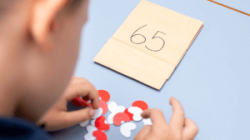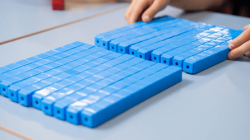Context
When a context is real and meaningful for children, their conversation relates to the context. They mathematize the situation… Mathematical questions arise.
Fosnot & Dolk 2001, p.21
reSolve teaching sequences are commonly shaped around contexts which are easily imaginable for students, such as real-world situations, imaginary stories, or from mathematics itself, through puzzles and curiosities. A real-world context provides a ‘hook’ or entry point for students to begin solving the problem, and for them to think and talk about the mathematics in a meaningful way.
Students should see the problems as interesting questions that are worth their effort. This only works, however, if the mathematical question is really integrated within the context (Van Galen 2013, p. 12).
It is important that the teacher chooses a context which embeds the mathematics within the problem, to support students’ thinking and their capacity to use their informal knowledge as a starting point for solving the problem. When the context of the problem reflects the mathematical ideas embedded within it, student talk is grounded in the context, and their strategies are specific to that context.
It is also possible for you to didactically craft the context. Here, you use the context to draw students’ attention to highlight mathematical ideas and understandings that you want them to notice.
reSolve tasks introduce the context at the very beginning of the lesson, during the Launch phase. The contexts support students’ construction of new understanding through the process of trying to solve the problem. This is different to lessons where ‘real-world’ problems are used at the end of a mathematics lesson, for students to apply skills and strategies that they have learnt during the lesson. reSolve tasks use context to support the teaching of new mathematical understandings through students’ problem solving.
reSolve Garden
Place Value: reSolve Garden is a teaching sequence that uses an imagined context which has been carefully crafted to model the embedded mathematics. This sequence develops the powerful mathematical idea that 10 ones is equal to 1 ten. This idea is embedded within the context of organising seeds, using a punnet to plant them, viewing the punnet of 10 seeds as a unit of ten, and recording the number of punnets and extra seeds as a number, using units of ten and extras.
Students engage with this realistic situation, participating in the context (organising seeds using ten) which supports their mathematical activity. As their understanding develops, students rely less on the context; their context-specific talk and strategies serve as footholds for working with more formalised mathematics. They become less reliant on the context of the task as they start to use the mathematics embedded within the problem to form generalisations.
Discuss with your colleagues
- Are there any ideas which are new to you here? What are they?
- When did you recently use a context in mathematics with your students? What was it and why did you use that particular context? How was your use of context similar to and different from the way context is used by reSolve?
References
Fosnot, C. T., & Dolk, M. (2001). Young Mathematicians at Work: Constructing Number Sense, Addition, and Subtraction. Heinemann.
Van Galen, F. (2013). Contexts and models in mathematics education. In: Zulkardi (Eds). The First South East Asia Design/ Development Research (SEA-DR) International Conference, April 22nd-23rd, 2013, Unsri, Palembang.
Place Value: reSolve Garden
Students learn that 10 ones can be grouped together to form a unit of 1 ten, and they apply this knowledge to two-digit numbers.
Representation
Effective teaching of mathematics engages students in making connections among mathematical representations to deepen understanding of mathematics concepts and procedures and as tools for problem solving.
National Council of Teachers of Mathematics, 2014
Mathematical ideas are abstract, so representations act as a tool to make these ideas visible and tangible. In the classroom, mathematics is modeled using different modes of representation, such as using blocks for counting, drawing a diagram, writing an expression, or verbally explaining a strategy.
As we use representations, they develop mathematical meaning for us. We internalise these representations as mental images of mathematical ideas. As a teacher, you have your own internal images of mathematical ideas that you have developed through experience. It is easy to assume that a representation which holds meaning for you will also be meaningful for your students. But this is not always the case. Representations are not transparent—students won't necessarily ‘see’ the mathematics in the model as you see it. Students need their own experiences for representations to become meaningful and to make mathematical sense with them. Students’ mathematical models should emerge naturally out of their own mathematical activity within a meaningful context.
Using representations to model mathematical ideas
It is important for the teacher to have a clear idea of the mathematics that students will come to understand, so that the models you select to use are intentional and explicit. It is critical for your students to model the mathematics, as it is only through students using representations that they become learning ‘tools’ with a purpose. You can support and monitor students to develop representations as thinking models into learning tools, to become more sophisticated over time:
- Models of - introduce the model through a realistic context, and students start to infer some meaning through this joint experience
- Models of - students use the model in their solution strategy
- Tools for - after more time, the model is internalised by students, as a thinking tool
This development process is closely connected to problem solving in a real-life context: as student thinking becomes more generalised, they reorganise their existing mathematical understandings, to discover connections and shortcuts which they apply to concepts and strategies.
Multiple representations
Teachers cannot expect students to fully understand the abstract nature of mathematics through a single representation, as this only partially models a mathematical idea. Students need opportunities to explore and represent the same mathematics in a variety of ways to develop a deeper, more connected understanding of an idea.
Representing a mathematical idea using different modes pushes students to translate their understanding from a representation they are familiar with to another representation of the idea. As they experience the mathematics through different models, they notice connections between the different modes of representation of the same idea. Students then reorganise their existing thinking to accommodate the new perspectives to deepen and enrich their understanding of the mathematics. It is only when students use representations to model what is in their heads, that these internal models become visible through their external representations.
Discuss with your colleagues
Think of a representation that you have you used recently with your students.
- How did you introduce this representation to your students?
- How did the representation make the mathematics visible for your students?
References
Gravemeijer, K. (1999). How emergent models may foster the constitution of formal mathematics. Mathematical thinking and learning, 1(2), 155-177.
National Council of Teachers of Mathematics (2014). Principles to actions: Ensuring mathematics success for all. Reston, VA: National Council of Teachers of Mathematics.
Task 2 of the Place Value: Lolly Shop sequence has been carefully designed so that the representation of Base 10 blocks emerges through students' mathematical activity. Read through the task here.
Task 2 • Rolls and boxes
Students learn to group ones to make tens and group tens to make hundreds, and develop the idea of “10 of these is 1 of those”.



